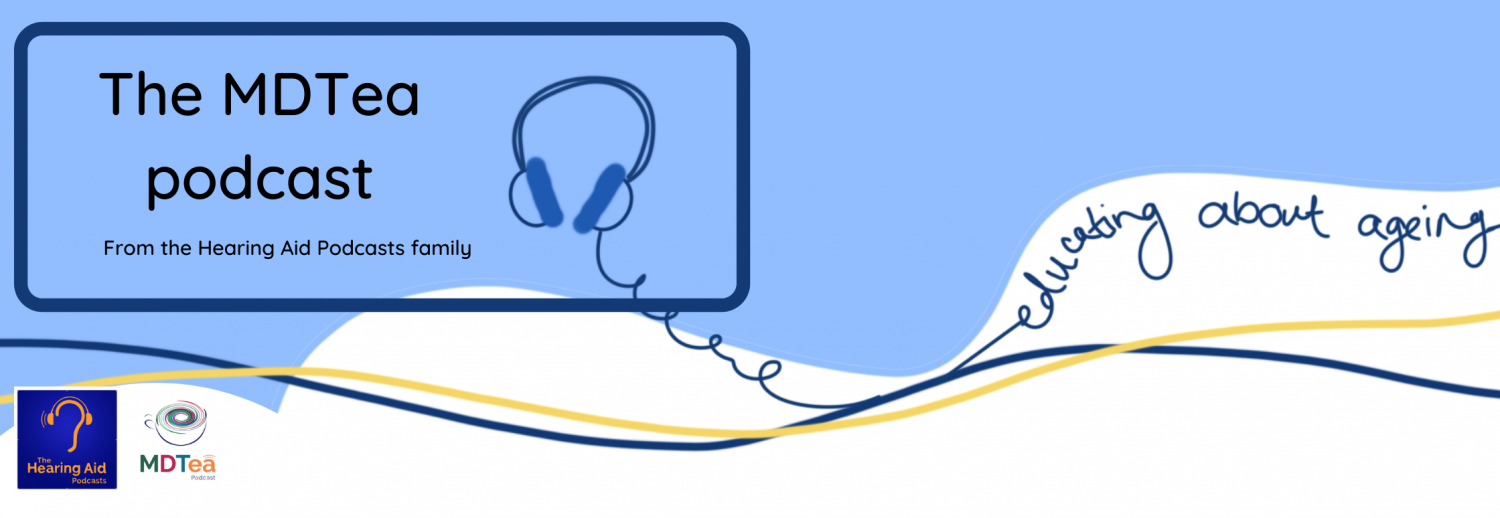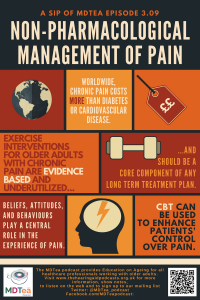Episode 3.09 Non-pharmacological Management of Pain
Presented by:
Dr Iain Wilkinson (Consultant Geriatrician East Surrey Hospital)
Dr Jo Preston (Consultant Geriatrician St George’s Hospital)
Guy Canby (Physiotherapy lecturer, University of Brighton)
Sarah-Jane Ryan (Physiotherapy lecturer, University of Brighton)
Faculty:
Mairéad O’Malley (Pharmacist)
Broadcast date: 6th June 2017
Click here for a PDF version of this infographic
CPD log
Click here to log your CPD online and receive a copy by email.
Episode 3.09 Show Notes Non-pharmacological management of pain
Click here to download a PDF of the show notes
Learning Outcomes
Knowledge:
- To understand the complexities of long term pain management in the older adult
- To appreciate current thinking around the use of neuroscience education approaches
- To appreciate current thinking around the use of physical activity in long term pain management
Skills:
- To be able to signpost your patient to the most appropriate professional/team to support them in managing their long term pain non-pharmacologically
- To be able to talk to patients about non-pharmacological therapies for the management of their pain, including self-management
Attitudes:
- To appreciate that long term pain is not solely a symptom of ageing
- Understand that effective non-pharmacological management requires a team approach incorporating the patient’s own understanding and beliefs
Social Media Spots this week
Here I breakdown a case of a frequent faller, and what medications I’m concerned about – med list review https://t.co/h7r84Oy2zq
— MedEd101 (@Mededucation101) May 21, 2017
Definitions:
- Pain is an unpleasant sensory and emotional experience associated with actual or potential tissue damage, or described in terms of such damage.
- Pain is always a subjective experience.
- No universally accepted definition exists for chronic pain
- Often defined as pain that persists beyond the expected time of healing (typically 12 weeks) and may or may not be associated with an identifiable cause or actual tissue damage
Management of chronic pain in older adults, Reid et. al BMj 2015
Practical Definition:
- Non-pharmacological = non-drug based approach
- Important as levels of pain high in older adults, likely to be under-reported
- Potential for side effects and interactions with polypharmacy.
Main discussion
For a recap on pain pathways, listen to Episode 1.7
- Two pathways, to the brain (afferent) and away from the brain (efferent).
- The brain is responsible for interpreting signals it receives as pain. The unpleasant element and the emotional component are ‘created’ by the brain.
There is a disconnect between tissue damage (nociception) and pain experienced. The relationship is not linear by any means; there are several other factors at play that influence how that pain is perceived.
Pain depends on how much danger your brain thinks that you are in, not how much danger you are actually in. This means that there is a ‘non-biological’ aspect to pain which can be modified e.g. through non-pharmacological means.
Gallagher et. al Clinical Journal of Pain 2012
Worldwide, chronic pain is costs more than either diabetes or cardiovascular disease. Chronic back pain is the most burdensome health problem worldwide
- Chronic neck pain 4th
- Migraine / headaches 8th
- Osteoarthritis 11th
- NB: Depression is 2nd, CVD is 23rd, dementia 24th, cancer 25th and malaria 41st…
Exercise
EULAR (European League Against Rheumatism) did a Delphi consensus on non-pharmacological management of osteoarthritis in the hip and knee.
- Weight reduction
- Walking aids, assistive technologies, changing chair heights, hand rails etc. – to decrease pain and increase participation.
- Individualised daily exercise regimen to improve strength and range of movement
EULAR recommendations for OA management
Exercise interventions for adults with chronic pain are evidenced based, underutilized, and should be a core component of any long term treatment plan.
Management of chronic pain in older adults, Reid et. al BMJ 2015
One large, cross sectional study of the Norwegian population attempted to look at associations between frequency, duration, and intensity of recreational exercise and chronic pain of 46,333 participants. Controlled for age, education, and smoking. The study showed that frequency, duration, and intensity of recreational exercise are all associated with a lower prevalence of chronic pain, and that the associations are stronger for older subjects, especially for women.
Psychological approaches
There have been several studies that show that psychological approaches to managing pain are successful. This one from 2014 showed that it can be achieved during a shorter time period than prev (3 months vs 2 years). 46.2% of patients achieved clinically significant change, and 58.9% achieved reliable change, in at least 1 key measure of functioning (depression, pain anxiety, and disability). Changes in measures of psychological flexibility significantly mediated changes in disability, depression, pain-related anxiety, number of medical visits, and the number of classes of prescribed analgesics.
This fits with known factors of poor outcome i.e. higher pain scores, disability and depression:
- higher levels of pain severity and disability,
- longer duration of pain,
- multiple pain sites,
- history of anxiety or depression,
- maladaptive coping strategies (for example, worry, avoidance),
- low social support at the time of diagnosis.
Management of chronic pain in older adults, Reid et. al BMJ 2015
Comprehensive Geriatric Pain Assessment domains
- Sensory: where, how, what etc..
- Emotional aspect: how is it affecting your mood? Sense of wellbeing? Energy levels? Are you worried about it?
- Functional impact: day to day activities, the things you enjoy, relationships with others?
- Sleep: how? Taking any meds to counteract?
- Attitudes and beliefs: about the pain and it’s treatment
- Coping styles
- Treatment expectations and goals
- Resources: who / what can you turn to when things are really bad?
CBT can be utilised therefore to enhance patients’ control over pain, because beliefs, attitudes, and behaviors play a central role in the experience of pain.
In one trial, investigators evaluated a CBT based self management program for use by older patients with chronic pain in primary care. Comparing those receiving CBT training with exercise only and a wait list control group.
Significant improvements in
- distress from pain,
- disability,
- self efficacy
Self management programs are based on similar principles but adopt more of an educational approach, merging physical, psychological, and social dimensions. The aim being to teach patients specific strategies to reduce pain by changing their behavioral, cognitive, and emotional responses to pain and building self efficacy for managing pain and its sequelae.
- Evidence is conflicting, with some citing benefits and others not.
- Intuitively it makes sense.
Pain in older adults can be a really challenging area. This qualitative study looked at stories from a range of people working with older adults (52: nurses, HCAs, PT, OT). Pain was perceived as:
- Exaggerated – evoked frustration in staff
- Care-related
- Self-caused
- Endured – evoked satisfaction
- Real
- Trivial
- Concealed
- Inarticulate
Various strategies to manage pain were used: no activity, medication, mediating contacts, distracting activities, physical therapies, mobility, work in a gentle way, rest or relieving pressure on body part, and communication concerning pain. The typology revealed that staff perceived older people in pain as a heterogeneous group and that their perceptions affected the pain-relieving activities that were offered.
Pain Management Pathways
PMPs, based on cognitive behavioural principles, are the treatment of choice for people with persistent pain which adversely affects their quality of life and where there is significant impact on physical, psychological and social function. (1++)
- There are no grounds for discrimination on the basis of age, literacy, litigation or judgement of motivation.
- Treatment should be directed at improving motivation and skills for behaviour change to achieve this.
Pain management treatment should be offered when indicated by persistent pain causing distress, disability and a negative impact on quality of life.
Common inclusion criteria include:
- Presence of persistent pain causing significant disability and/or distress.
- The participant is willing to participate in a group. R 5.11 Common exclusion criteria include:
- The participant has a limited life expectancy or rapidly deteriorating disease or condition.
- Uncontrolled psychosis and moderate-to-severe cognitive impairment are contraindications.
There are other issues which have been treated as obstacles but for which there is no evidence that alone they render treatment unsuitable:
- Older adults; there is evidence that older participants are able to benefit from PMPs (Cook, 1998). (1+)
Impaired cognition or concentration warrant special consideration as to whether PMP is suitable – need to be able to participate in cognitive activities.
There is evidence that ‘neuroscience education’ works not only to affect the pain perceived by the individual but also associated disability, anxiety and stress they experienced.
Resources
If you have some links or resources you’d like to share, get in touch and we’ll add them here. Twitter @MDTea_podcast Facebook www.facebook.com/MDTea or email thehearingaidpodcasts@gmail.com
Curriculum Mapping: This episode covers the following areas (n.b not all areas are covered in detail in this single episode):
| Curriculum | Area |
| NHS Knowledge Skills Framework | Suitable to support staff at the following levels:
Personal and people development level 1-3 Service improvement level 1 |
| Foundation Curriculum 2012 | 2.1 Treats patient as centre of care
6.1 Lifelong learning 10.1 Manages patients with long term conditions |
| Foundation Curriculum 2016 | 2. Patient centred care
4. Self-directed learning 10. Support for patients with long term conditions |
| Core Medical Training | Common competences:
System specific competences:
|
| GPVTS program | Section 3.05 – Care of older adults
Section 3.20 Care of people with musculoskeletal problems
|
| ANP (Draws from KSF) | Section 7.12 Pain (acute)
Section 7.25 Pain (chronic) Section 20. The patient as central focus of care Section 35. Psychological, social, cultural, ethnic and economic factors |





